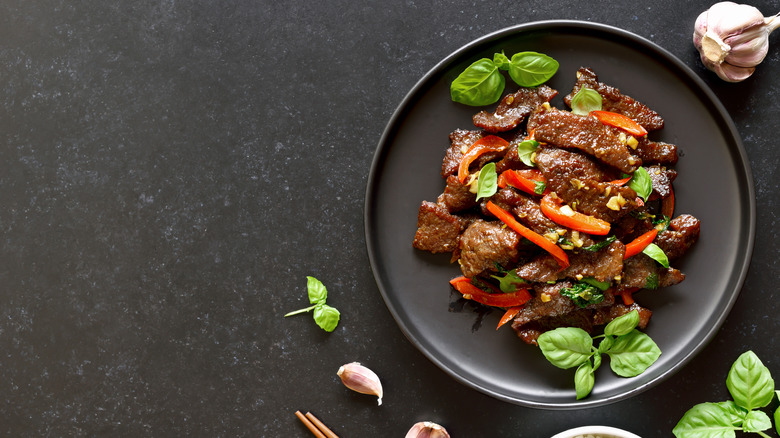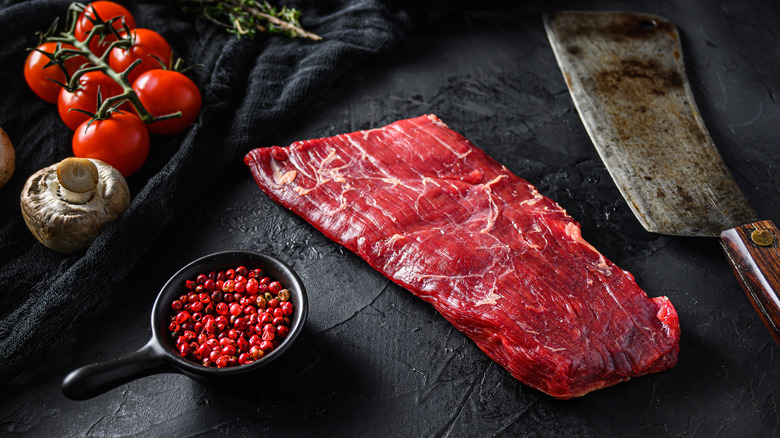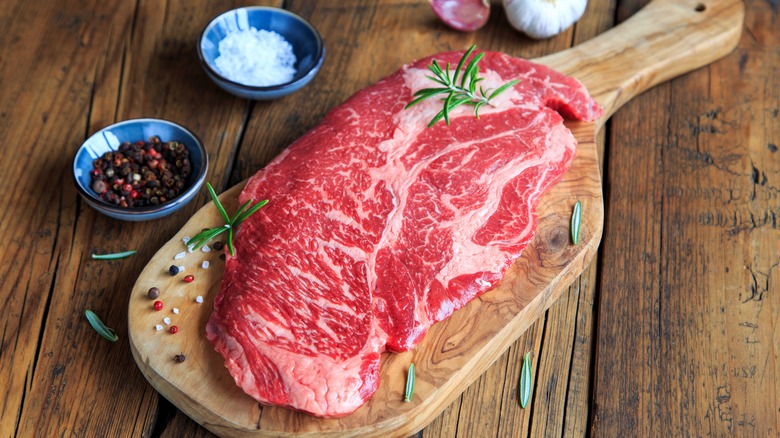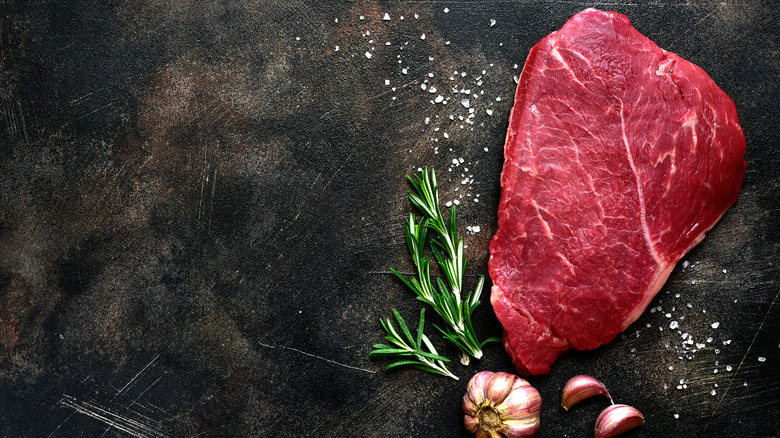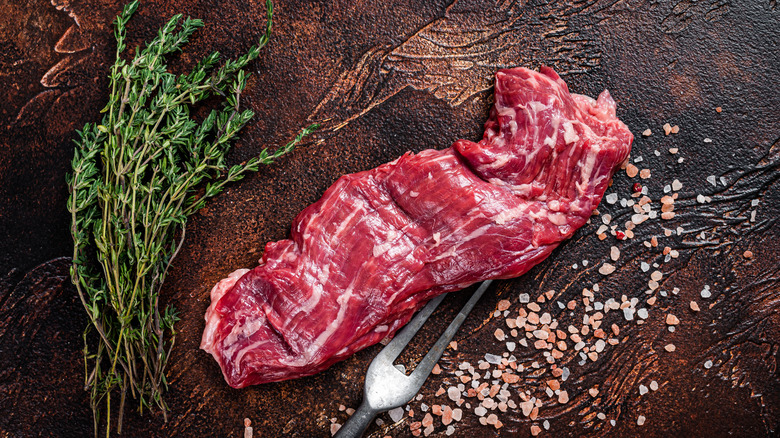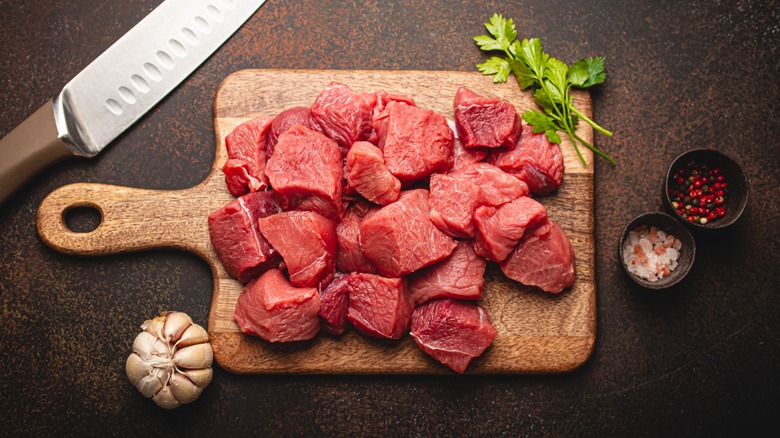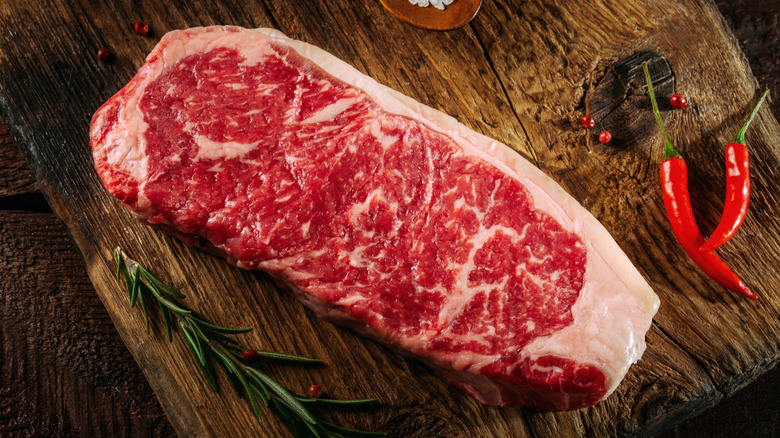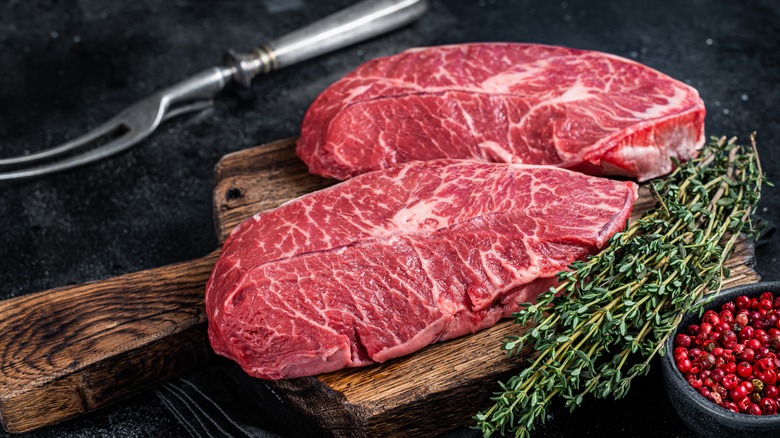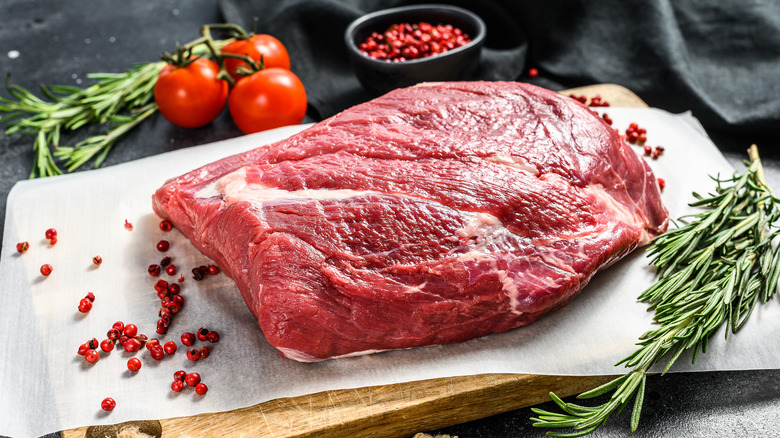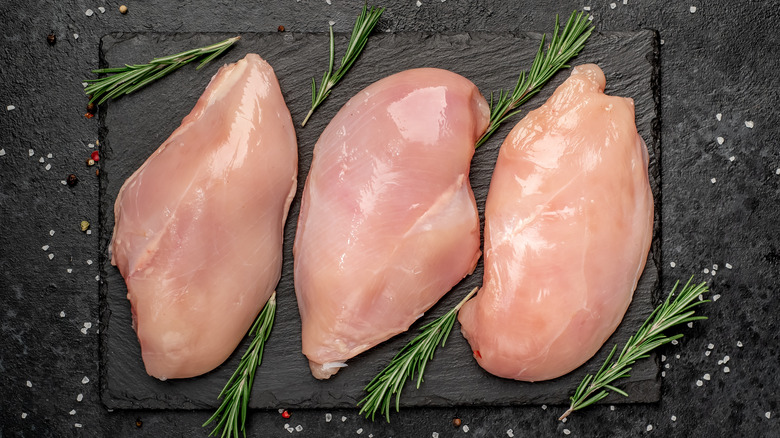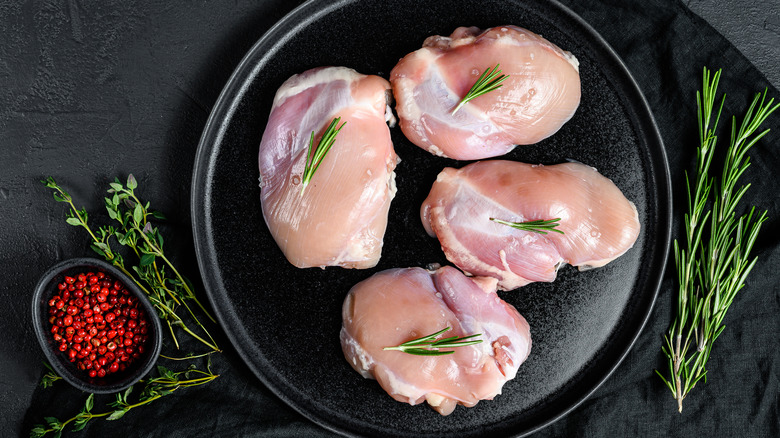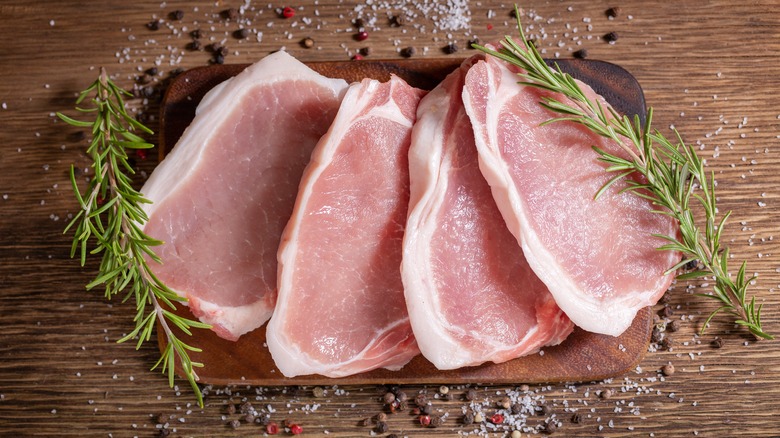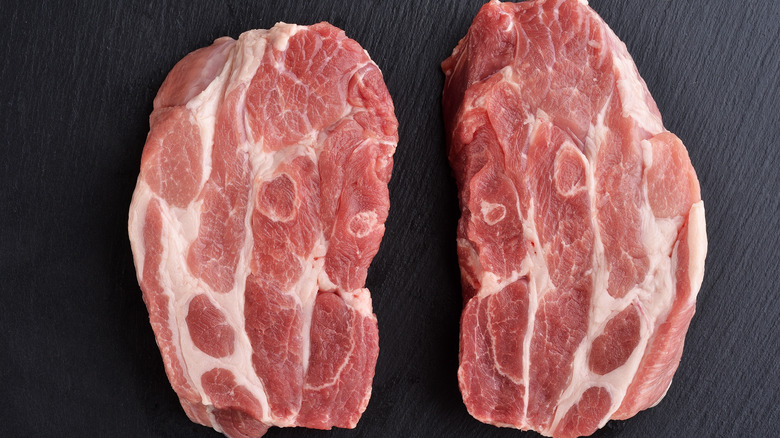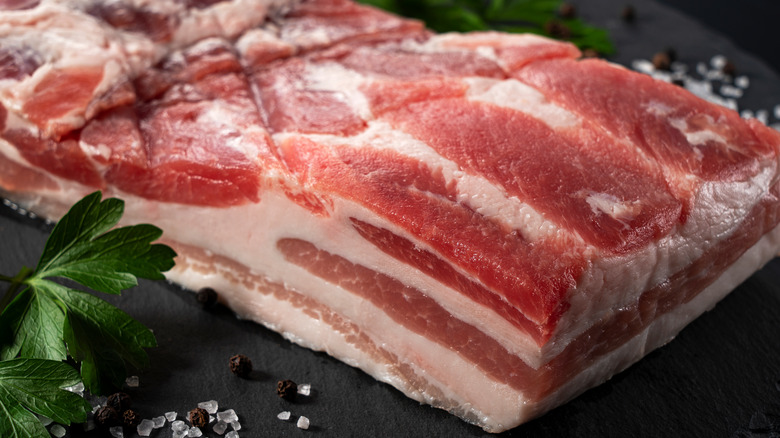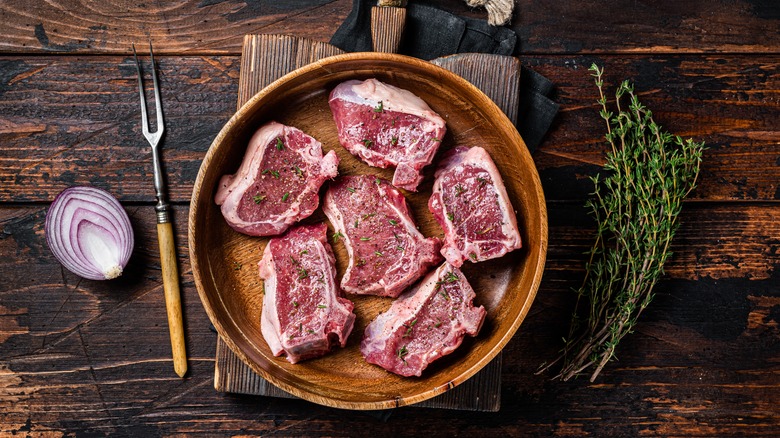The Absolute Best Cuts Of Meat For Stir-Fry
If you're looking for an easy weeknight meal that packs in protein and veggies, then stir-fry is going to be your new best friend. Stir-fry is traditionally made with thin slices of protein, cooked very quickly in a hot pan. Fresh, crisp vegetables are added, and you can serve them with rice or with many different types of noodles. Whether you use beef, chicken, pork, or lamb, choosing the right cut is of the utmost importance. The texture of the meat depends on where the butcher cut it from the animal. According to Texas A&M University School of Agriculture and Life Sciences, muscles that are used more will produce leaner, tougher cuts of me. At the same time, less-used parts of an animal have more fatty marbling and tenderness.
You'll also want to consider the grade when selecting meats for stir-fry. The U.S. Department of Agriculture explains that marbling, along with the animal's maturity, the meat's color, and the muscle's firmness, are all part of that assessment. We recommend sticking with meats that earned a Choice or Prime grade, as these will have the best mixture of both. As food prices remain high, our picks for the best meats for stir-fry, along with some tips for preparing them, will help you make the most out of turning your groceries into a delicious meal.
Flank steak
Flank steak is arguably the most suitable cut of beef for stir-fry. Butchered from the abdominal muscles of the cow, the long flat is lean but high in protein (via Chicago Steak Company). This cut has a rich, beefy flavor, with a texture that can be softened if cooked and marinated correctly. Its attributes make it perfect for any stir-fry dish (and home cooks can also use it in fajitas and stews).
One important flank steak cooking rule you can't skip is to use high heat and cook it quickly. According to Food Network, as the grain of flank steak can be very long, it does well with a marinade to eliminate any toughness. To marinate flank steak, slice it thinly into strips. Choose a stir-fry sauce recipe and pour it over the steak strips. Marinate for at least 30 minutes or up to overnight. Cook on very high heat for only a few minutes in a wok or on a grill, and enjoy a flavorful steak stir-fry.
Beef chuck steak
Chuck steak is not to be confused with a chuck roast. According to Chicago Steak Company, the chuck roast is cut from the shoulder area below the rib and above the brisket. A beef chuck steak is then a portion cut from that large slab of meat. It has a rich, beefy flavor and is an affordable cut of meat for stir-fry. Chuck can come with or without the bone, but we recommend always choosing boneless for stir-fry. Since chuck steak comes from a leaner part of the cow, you will need to cut it properly to ensure it is chewable in your stir-fry recipe.
As with all meat in this list, you want to cut beef chuck steak against the grain when preparing it for stir-fry. The grain is the pattern in which the muscle fibers run within a cut of meat. In this case, cutting steak against the grain is important because it shortens the muscle fibers and makes certain cuts of beef softer and easy to chew. Chuck steak's grain runs vertically, so start by cutting the steak into long chunks and then looking at the grain on the inside of the steak. Chop the beef into pieces against the grain and then slice into smaller, thinner strips.
Top sirloin steak
Top sirloin is a bit more expensive than beef chuck steak, but it is more succulent and slightly marbled with fat for amazing flavor. The top sirloin is cut from the sirloin primal, located between the back of the ribs and the rear of the cow (via Chef's Resources). It has an intense flavor, and its soft and easy-to-nibble quality adds a great addition to your favorite stir-fry.
Top sirloin is the cut of choice for many chef's stir-fry concoctions, such as Andy Ricker, who chooses it in a spicy Thai beef and vegetable stir-fry recipe. Slice the sirloin into thin, uniform pieces for the best results. You want it to cook fully within just a couple of minutes before adding additional ingredients such as chiles, long beans, and baby corn to the mix. Since sirloin is not overly tough, you do not have to marinate it before adding it to your dish, making it a great choice for a quick and easy weeknight stir-fry.
Skirt steak
Skirt steak is another great cut of meat for a stir-fry and is very similar to flank, despite originating from a different location on the cow. Taken from the cow's plate, the long flat cut is full of flavor (via Omaha Steaks). Keep in mind that there are two cuts of skirt steak: the outside skirt and the inside skirt. The outside skit is a boneless part of muscle attached to the underside of the cow's ribs. It is usually a smaller cut and more tender than the inside skirt, which is a boneless portion of the cow's flank. We recommend choosing the outside skirt for stir-fry.
While this cut of steak is delicious in our selected dish, it can be less delicate than some other cuts. You'll want to cut against the grain and slice it quite thin. To get the desired width and uniform slices of skirt steak, a great freezer tip is to thinly slice your meat after stashing it in the icebox for 15 to 30 minutes. It will make the meat more firm so your knife can easily cut through.
Beef tenderloin
If you want to treat yourself to a sumptuous stir-fry, try using beef tenderloin. Chicago Steak Company notes that the popular filet mignon is cut from the tenderloin, giving you a good sense of how juicy and flavorful this hunk of meat is. Beef tenderloin works well with high-heat cooking in a wok or skillet because of its lack of toughness. It should come as no surprise that tenderloin's decadent flavor and easy-to-work texture make it one of the pricier cuts of beef for stir-fry. But in our opinion, it is worth every penny.
To choose a great tenderloin for stir-fry, you'll want to look for a cut that is about one-and-a-half inches thick that has been trimmed of fat. When cutting tenderloin, you'll notice the grain is very hard to see because the muscle fibers are thin. This means that beef tenderloin will be easy to chew no matter how you cut it. Strips of tenderloin are delicious when pan frying, but you can also cut them into bite-sized cubes.
Strip steak
Strip steak is a very common menu item to see at steak houses, and for a good reason. It is also known as the New York Strip, and while it is not the cheapest cut for stir-fry, it is more affordable than a beef tenderloin or a ribeye steak — both pieces being that have a similar composition in terms of fat, intramuscular tissue, and meat. Among the things you should know about NY strip steak is what to look for when purchasing. We recommend focusing on an even width that stays consistent throughout the steak. Your cut should also have just ⅛-inches of fat, which means it was cut from the center of the strip loin and will ensure great flavor and juiciness for your stir-fry.
Strip steak has a delicious, mineral-rich taste. Chicago Steak Company explains that this cut comes from above the belly, which gets very little exercise and results in a softer makeup that is easy to eat and ideal for the high-heat method of stir-fry cooking. This cut of steak tastes best when cooked to no more than medium temperature and marinaded for a few minutes in soy sauce, sugar, and Chinese cooking wine.
Flat iron steak
The flat iron steak as we know it was not "discovered" until 2002, per Omaha Steaks. The cut itself was long considered an unusable piece of beef due to a tough connective tissue and sinew that runs through the bulk of the meat. This was the case until researchers from the University of Nebraska and the University of Florida came up with an inventive new way to trim said meat, resulting in a tender, easy-to-chew steak known as the flat iron. Intramuscular marbling makes it a prime piece of beef for high-heat cooking, as the fat keeps things moist and eatable.
Almost as supple as the sirloin, according to Certified Angus Beef, flat iron steak has an intense grassy flavor and exceptional fat marbling. However, that doesn't necessarily translate to an unhealthy amount of fat; as Chicago Steak Company reports, a serving has only 3 grams of saturated fats. This composition turns flat iron steak into an ideal cut of meat to consider for stir–fry recipes. It cooks better when marinated rather than thrown directly on the grill. Yet, either method you choose, the marbled fat gives it a juicy texture that is also great in fajitas or alongside our silky cauliflower purée recipe.
Round steak
A round steak is a cut from beef rounds or the cow's hind legs (via Tony's Meats and Market). These cuts are similar to the loin and rib cuts but are not as pliant because they come from a very active and exercised part of the cow. Just like the sirloin, there are top round and bottom round steaks. As BBQ Host explains, top rounds steaks are from the inner back leg of a cow and have less fat. Bottom round steaks are cut from the outer part of the back leg and have a bit more marbling.
Since round steak is from a hard-working muscle, it does well with a method called velveting, a Chinese cooking technique that achieves the most tender meat possible. Velveting is a process of making tougher cuts of meat softer by slicing them thin and marinating them in a mixture of corn starch, egg white, rice wine, and salt. You'll let the meat sit in the refrigerator in this marinade for 30 minutes and then par-cook it quickly in hot oil. This creates meat that is succulent and velvety in stir-fry recipes. This technique can be used on all meats, but the ingredients in the marinade may vary. Tougher cuts like round normally call for long spells under moist heat, but with velveting, you can cut the preparation time all while priming your steak for new possibilities.
Boneless skinless chicken breast
Chicken breast is a nutritious and low-fat choice for meat in a stir-fry. According to the Academy of Nutrition and Dietetics, a 3-ounce boneless, skinless chicken breast yields 140 calories, 3 grams of fat, and 1 gram of saturated fat. Chicken breast may have a reputation as a demanding cut (we all know the displeasures of overly dry chicken), but Reader's Digest suggests you can negate this with velveting or other tenderizing techniques.
When prepared correctly, chicken breast is a juicy and flavorful addition to your meal. One chicken breast cooking tip we recommend is to always start by pounding your poultry flat until it has a level of thickness. This helps the chicken cook evenly and defends against dryness and overcooking. Pounding the chicken also softens it, so you have the perfect-sized bite in your favorite chicken stir-fry. Chicken meat, like beef, also has a grain. You'll get juicy and easy-to-chew chicken by cutting against that grain pattern. Chicken breasts can also be cut into strips or chunks. Just be sure they're no wider than one inch for either type of cut and that all the pieces are uniform in size.
Boneless skinless chicken thighs
We couldn't list chicken breasts without listing the chicken's delicious dark meat section. Chicken thighs are slightly less nutritious when compared to their white meat counterparts, but only because they contain more fat. According to the U.S. Department of Agriculture, a 70-gram boneless, skinless chicken thigh has 135 calories and 7.5 grams of fat. Thighs are also more cost-effective than chicken breasts (and many other types of meat on this list, for that matter). They can be more flavorful, too, as long as you avoid the common mistakes everyone makes when cooking chicken thigh. Like breasts, be sure to cut your chicken thighs into uniform strips or chunks to ensure even cooking.
The decadent fat of chicken thighs adds richness to your favorite stir-fry recipe that you can't get from boneless skinless chicken breasts. Both chicken thighs and breasts pair well with citrus, though we think that thighs have more natural umami to them. We love using either cut for our orange chicken stir-fry recipe or using them to add lighter calorie meat to an already hefty winter vegetable stir-fry recipe.
Pork loin
While beef and chicken are two of the most popular varieties of meat for a stir-fry, there are many cuts of pork that shouldn't be overlooked. Take pork loin, for example. Pork loin can be described as a thick hunk of meat that is butchered from between the back fat and the pig's ribs. It is worth noting that pork loin comes in two forms, the second being a cut called the pork tenderloin. While extra lush, we find tenderloin to be a bit too expensive for stir-fry. Pork loin usually has a cap of fat along its top, which gives it that lavish, moist flavor. Most commonly, pork loin roasts are sold boneless, which you'll want for stir-fry. Additionally, we also recommend buying pork loin that has been pre-cut into pork chops at the grocery store. This will save you time and money in your stir-fry.
To prepare, cut the chops into strips or cubes, uniform in size, for quick and even cooking. Because of its place and usage on the pig, pork loin is a soft and juicy cut that adds a unique and distinct flavor to stir-fry. It is richer than the neutral flavor of chicken put merges with added ingredients more than the full-bodied boldness of beef. In particular, the loin soaks up marinades and is accentuated by ginger, garlic, chilis, and any other ingredients that will lead you to excitingly spicy stir-fried pork recipes.
Pork butt
The name "pork butt" is slightly confusing. It doesn't come from a pig's rump at all. Instead, it comes from its shoulder. Though, it should not be confused with pork shoulder. As Cook's Illustrated describes, pork butt is a cut from higher on the pig's foreleg, while pork shoulder is cut farther down. Pork butt contains more fat than pork shoulder and is a more supple cut of meat. The pork shoulder is leaner and has more muscle, making it a slightly tougher cut. It's also worth noting that any part of the pork shoulder, which includes pork butt, is going to have a more intense porcine flavor than lean cuts like pork chops. Pork butt is often cooked using low-and-slow techniques, such as pulled pork or Mexican carnitas, but is also delicious in a stir-fry.
Since pork butt can be slightly tougher than some other cuts of pork or beef, the velveting technique for tenderizing should be employed here. You do not need to pay attention to cutting with or against the grain as you do with beef, but it does do well if you freeze it slightly beforehand. You can also cut pork butt into chunks or strips for stir-fry.
Pork belly
A decadent option for stir-fry, pork belly comes from the pig's underside. If you get it unsliced, the belly is a long cut of meat weighing up to 12 pounds (via Detroit Free Press). By curing, smoking, and slicing pork belly, you get bacon. But when it is left uncured and unsmoked, it is perfect for a saucy stir-fry. Rather than thin strips that are too reminiscent of bacon, you can cut the pork belly into thicker, half-inch chunks. The result is a stir-fry with salty bits of fat throughout, which will slightly render when exposed to the high heat methods needed to cook this dish.
While most other meats on our list call for thin slices and quick cooking, pork belly needs a little longer. Rather than two minutes, cook pork belly for closer to six minutes in your stir-fry. Since it is such a rich and fatty cut of meat, it pairs well with crisp, fresh veggies and a slightly sweet sauce. We recommend a teriyaki or even a Kalua pork belly and soy sauce marinade recipe, both of which tie a slight saccharine accent to the umami-packed notes of this meat.
Lamb loin
Lamb is another protein option for stir-fry, though an uncommon one. It is not often discussed, but it can add a unique twist to your stir-fry. Compared to beef, lamb can be even easier to chew though it's a bit firmer in texture. Much like pork loin, lamb loin adds great robustness to stir-fry. With lamb, you will have a slightly gamey flavor that will make your dish taste rustic. Lamb loin comes from the center of the lamb, close to the spine, and extends towards the rear quarter (via Fine Cooking). This cut is a soft and flavorful part of the animal, though some pieces of the same cut will have a different flavor, as a young lamb can develop almost a sweet accent.
There are many mistakes you need to avoid with lambs, such as knowing which cuts do well with slow cooking and which (like lamb loin) are great for searing or other high-heat, quick cook methods. Be sure to trim the excess fat from the lamb to boost the flavor and moistness. You should also cut lamb loin into strips against the grain for the best mouthfeel. Lamb pairs well with a combination of sweet and salty, so a Mongolian stir-fry recipe is an ideal way to use this meat. If the recipe calls for beef, you can easily substitute lamb and get the same great flavor.
Lamb topside steak
If you've ever wondered, "which is better for me, lamb or beef?" this next cut is for you. Lamb is a great option if you want to dine on stir-fry with a healthy conscious. When compared among protein choices, lamb has a more nutritional profile in terms of omega-3 fatty acids. It is also loaded with minerals and vitamins that many types of commercial meat lack (via Healthline). After lamb loin, the topside may be your best bet for stir-frying.
Meat and Livestock Australia describes lamb topside as great for stir-fry because of its intense flavor and supple qualities. As it is a leaner cut of meat, there is minimal fat content, but it's still juicy when cooked properly. To prepare lamb topside for stir-fry, cut it against the grain into strips and marinate it before cooking. The grassy, woodsy flavor of lamb goes hand in hand with cumin-focused stir-fry. Create a spice mix of cumin and crushed Szechuan or black peppercorns, then stir-fry the marinated lamb along with sliced peppers, onion, fresh ginger, garlic, and the spice mixture. Stir in a dressing of soy sauce, rice vinegar, and corn starch, and this flavorful lamb dish will be ready to go on a bed of rice topped with cilantro.
